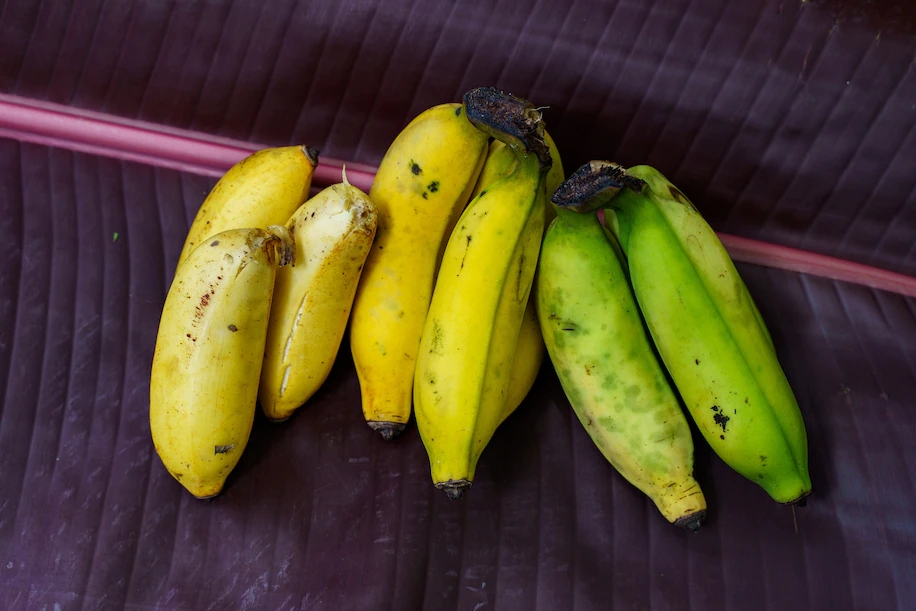
A report by Alicia Kennedy for The Washington Post.
Bananas grow so well in Puerto Rico that people are constantly giving them away. My neighbors in Old San Juan will go out to the country for the weekend and start knocking on your door come Monday, asking if you would like a bunch. Saying yes can be dangerous, I’ve learned, because you could find yourself with 10 pounds of guineos niños, also known as ladyfingers. That’s more than enough for four loaves of banana bread and a daily burst of potassium in the morning’s oatmeal. It’s more bananas than anyone really needs. But the bananas keep coming.
More than 90 distinct kinds of banana have been grown and catalogued by the USDA Tropical Agriculture Research Station in Mayagüez, not including plantains or ornamental varieties. That means that locally, “banana” or “guineo” needs a modifier, because it doesn’t only refer to the popular Cavendish variety that is well known in the United States (of which many subvarieties also exist). Here, that’s guineo flaco, or skinny banana. It’s the one that I and most folks in the United States grew up eating, though, and so moving to San Juan has been a mind-altering experience where this fruit is concerned. While I had known that there were bananas of varying colors, textures and flavors, they had all been locked away from me in the tropics, only to be admired from afar. Now, I am almost overwhelmed by their abundance.
But bananas, like every foodstuff that grows in the Global South and becomes a beloved commodity in the Global North, have a rather sordid history. Scientists and other researchers have agreed they originated in South Asia and made their way west, eventually landing in the Greater Antilles of the Caribbean, of which Puerto Rico is part, from the Canary Islands in 1516. It wasn’t until the late 1800s that they became an everyday good for consumers in the United States and Europe. Heavy-handed U.S. companies bought up land in Central America and the Caribbean, where workers were paid little and the fruit companies used their power to sway local governments (which would come to be pejoratively referred to as “banana republics”). Colombian workers for the United Fruit Company, now Chiquita, went on strike in 1928 and were gunned down by the Colombian army, at the behest of U.S. business interests in the region.
Conditions for banana workers generally have not gotten much better. According to the Food Empowerment Project, “buying conventional bananas contributes to both environmental and human rights abuses” even in 2021. Their ubiquity and popularity are to blame: Bananas are sold cheaply because workers are paid poorly at the origin, and often pesticides are used that degrade both their health and the health of the local environment.
Because we are eating, in most cases, only one kind of banana — the Cavendish — the lack of biodiversity makes the plant very susceptible to disease. Headlines have said for decades that we might soon see the end of the Cavendish, just as the Gros Michel fell out of high-volume production because of Panama Disease in the early 1900s. At the USDA’s Tropical Agricultural Research Service in Mayaguëz, which opened in 1901, they study potentially more resilient types of banana, given that they grow so well there. Their hope is to find a variety that is resistant to disease, specifically the fungus Tropical Race 4, but considering how easy it is to wipe out a whole crop when only one variety is grown, the answer seems to be biodiversity and becoming accustomed to “banana” not meaning just one flavor and color.
Agroecological farmers encourage biodiversity for this reason. Not only is it more interesting to eat a few different kinds of this fruit, it’s more healthy for the soil and keeps disease at bay.
At Finca el Paraíso in Arecibo, farmers Jaime Jordán and Nina Craig grow six varieties of banana. The ones they bring to the weekly farmers market in Old San Juan are the guineo flaco, guineo manzano and guineo morado. They work their land alone, with help from a neighbor just two days a week. Craig came to Puerto Rico two decades ago as an environmental biologist studying the habitat of a local parrot, while Jordán grew up in nearby Utuado in an agricultural family and studied agronomy (he’s also an artist). Their expertise is complementary, leading to a bounty at the weekly market. Even though neighbors drop off bunches of bananas for me regularly, I always buy from Finca el Paraíso’s selection, because they taste like nothing I’d ever had before. Visiting the farm helped me understand why.

Every part of the farm, where they also grow various greens, plantains, ají dulce peppers, ornamental and edible flowers, and more, is tended to by hand: the maintenance and the digging. Craig tells me most of the banana plants were there when they bought the farm in 2010, and they don’t require much work because of a supply of groundwater. Jordán tends to the dead leaves with a machete, and that keeps them going; the trees are competitive when it comes to space, so they can’t be overcrowded.
“After Hurricane Maria, they all tried to grow back at once,” Craig tells me. It took years for them all to grow and fruit in the same way (Craig, Jordán and their son also spent 10 months living in their garage while their house was rebuilt from the destruction). They’ve planted “dwarf” Cavendish plants, because the shorter and stockier trees stand up better to extreme weather, while tall trees are easily knocked down. Having the diverse varieties together has made their crop less susceptible to disease; bananas, she says, need less care than plantains.
Their most popular variety by far are the guineo manzano, which are small like the guineos niños and yellow like a Cavendish. I fell in love with them when, in the midst of a pandemic fall, I realized how much I missed the taste of an apple and didn’t want to go to the supermarket for a commodity variety that had spent weeks on a boat. When Craig told me these taste like apples, with a somewhat firm texture and tart flavor, I had found my perfect satisfaction for a faraway craving. Though they’re unmistakably a banana, their essence is quite different.
Lately, I’ve been eating more of the red guineo morado, a squat, fat banana with red skin that is ripe when it turns pink and spotted. That can take many days from their harvest. In my hot, humid kitchen, plantains turn yellow within a day, but the morados sometimes aren’t ready for five days. When they do ripen, their texture is creamy and rich; while the flesh is yellow on the outside, inside it is orange like the yolk of a farm-fresh egg, and there is more subtlety of flavor than with a Cavendish.
Bananas are so abundant here, I’ve even considered using the peels as a meat substitute, as there are numerous recipes where it can stand in for pulled pork, bacon and in curries.
But in Puerto Rico, where they grow so well as a plant of the “wet tropics,” it’s the flesh that is used in many traditional dishes. Green, unripe bananas are grated and become the basis of pasteles and fried alcapurrias, forming a dough with other starchy viandas, or root vegetables. Another dish, guineos en escabeche, is where the unripe banana is essentially pickled in a ceviche-like preparation. It’s even possible to make tostones de guineo, the twice-fried snack, and bolitas, a dumpling for soup — both of these are usually made with the starchier green plantain.

The food writer César Pérez Medero tells me, “One of the first things I ever used to cook for myself as a kid was Lipton soup from the packet with a few leaves of recao [an herb] thrown in and a side of boiled guineo with olive oil and salt.”
But many bananas still go to waste, especially those that are sold in supermarkets. To try to make something of the glut of fruit, Rodrigo Lloveras and Elizaveta Stakhanova have started the Lizkas Initiative, in which they partner with supermarkets to take the bananas that would go in the trash so they can make vegan muffins for retail and wholesale. In addition to recovering that waste, they also use bananas from their farm in Ciales, where not only guineos niños and manzano are grown, but even the once-lost Gros Michel.
“On a weekly basis, it’s about 35 to 45 pounds of bananas” that they’re recovering from supermarkets, says Stakhanova. “And I think the most important part is that we use every single bit of the banana. Everything that we don’t use, we compost; at supermarkets, they just put it into a landfill. So we give it a full cycle of life and make it sustainable,” she says.
As the United States continues to eat the Cavendish and worry about its demise, in Puerto Rico, robust crops of different varieties are being sold by small farmers, used in the cuisine, and turned into vegan muffins and compost. Though this is a colony where 85 percent of food is imported, a culture of agriculture and farming wisdom remains, represented in the bounty of bananas and the generosity contained in each bunch.
No comments:
Post a Comment